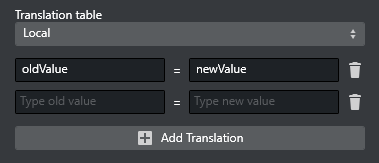
Viz Channel Branding User Guide
Version 5.1 | Published October 26, 2023 ©
Translation Tables


Translation tables can be used to define arbitrary value-translations, via an oldValue=newValue table. There are two kinds of translation tables:
-
Local: settings configured locally per page field.
-
Global: the Global Translation Table can be configured in Channel Settings under Page Content Filling > Translation Tables.
-
Match and replace rules in translation table: There are some special characters can be used in the old value (left part) of the translation table that have special rules when trying to match and replace the value. It also supports partial match, * means one or more characters, ? means one character.
Symbol(s)
Description
Examples
*
Match and replace - wildcard pattern
-
He*=cat - "He is an old dog" is translated to "cat".
-
H*g=cat - "He is an old dog" is translated to "cat".'
-
d*=cat - "He is an old dog" has no match and the result is "He is an old dog".
?
Match and replace - wildcard a specific number of characters
-
He???=Goodbye - "Hello" is translated to "Goodbye".
-
He??o=Hi - "Hello" is translated to "Hi".
-
H?=cat - "He is an old dog" has no match and the result is "He is an old dog".
()
Match and replace a substring
-
(d*)=cat - "He is an old dog" is translated to "He is an old cat".
-
(??)=cat - "He is an old dog" is translated to "cat cat cat old dog".
-
(o*)=cat - "He is an old dog" is translated to "He is an cat dog".
-
(*o*)=cat or (?o*)=cat - "He is an old dog" is translated to "He is an old cat".
[]
Match and replace the character.
[o]
=x - "He is an old dog" is translated to "He is an xld dxg".
[er]
=PPP - "He is a very old dog" is translated to "He is a vPPPy old dog".
[d?d]
=123 - "He is a very old dog" is translated to "He is a very ol123og".
-